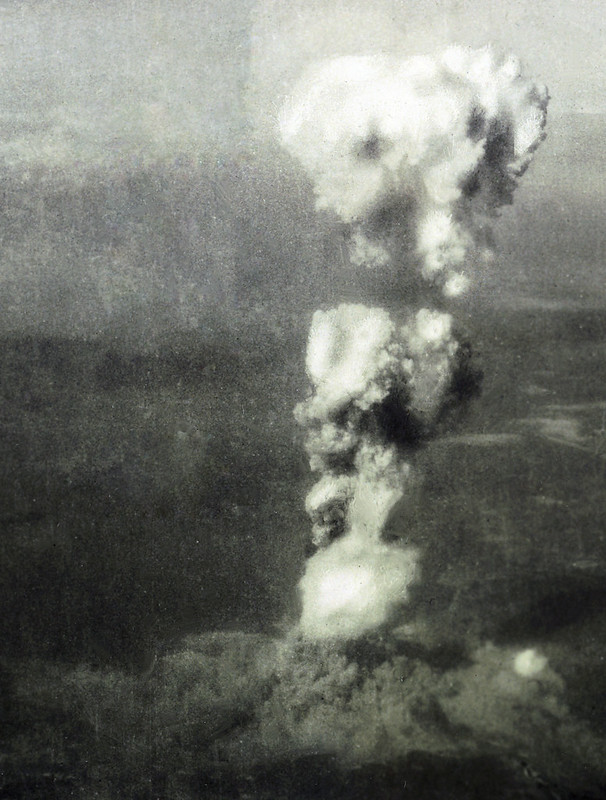Dust, Drought, Depression, and War No. 181

At Hiroshima: A tall column of smoke ascends 20,000 feet over the city after the first bomb fell on August 6. A cloud of smoke 10,000 feet in diameter covers the base of the column. This picture was made after the missile2 was loosed from an altitude of between 20,00 and 30,000 feet [The New York Times (U.S. Army Air Force)]3
The New York Times,
Sunday, August 12, 19454, 5
The Allied powers have agreed to the Japanese proposal to surrender on the basis of the Potsdam ultimatum, but on the condition that the Japanese Emperor come under the authority of the Allied Commander in Chief to act as his agent to assure the full accomplishment of the armistice terms. President Truman, in the name of the Allied powers, informed the Japanese that the Emperor’s future status must be determined in a free election and that Allied troops would remain in Japan long enough to see that the democratic purposes of the Potsdam ultimatum were accomplished.
General MacArthur was reported designated the Allied Supreme Commander to accept the surrender of Japan.
Tokyo newspapers were preparing the people for capitulation, emphasizing the theme that it was the duty of a nation not to commit suicide.
Moscow reported sweeping gains all along the Manchurian front and revealed that Marshal Vasilevsky was in supreme command of the Far Eastern theatre. On the Trans-Baikal front an advance of 155 miles has been made in two days.
Generalissimo Chiang Kai-shek ordered his armies to keep on fighting until the order to cease fire is received. Chinese troops occupied Tsangwu on the road to Canton.
Admiral Nimitz in a communiqué issued Sunday morning Guam time made no mention of further attacks on Japan. He had previously issued orders to all forces under his command to continue attacking the enemy. Five hundred Far East Air Force planes on Friday smashed at the city of Kumamoto on Kyushu, a military supply center.
It was officially revealed that the atomic bomb that erased a third of Nagasaki had a revised destructive function that made the first one, which was used on Hiroshima, obsolete.
The record to date shows that Japanese Kamikaze fliers have sunk twenty United States warships and damaged at least thirty more.
General de Gaulle and Foreign Minister Bidault are to come to the United States the last week of this month on invitation from the White House, it was disclosed in Paris.
Prosecutor André Mamet, summing up the State’s case against Marshal Pétain, demanded the death penalty.
WASHINGTON, Aug. 11 (AP)—The surrender of Japan calls for liberation for about 16,700 Americans presently interned in the enemy home island or Japanese-occupied territory, a check of War, Navy and State Department records disclosed today.
- Each blog post in this project is an exploration of something from the almost 16 years between the crash of the stock market in 1929 and the end of World War 2 in 1985—no limits, no specific focus. The arc of the project will be the depression, the dust, the drought, and the war, but there were a lot of other aspects in the America of those times.
- Historically, the word missile referred to any projectile that is thrown, shot or propelled towards a target; this usage is still recognized today.
- “Missile.” Wikipedia, as edited August 19, 2021. Accessed September 13, 2021. https://en.wikipedia…Missile.
- “Smoke and Fire Reach Toward the Sky as Atomic Bombs are Dropped on Japanese Cities.” The New York Times. August 12, 1945. page 28. Accessed September 13, 2021. https://timesmachine.nytimes.com…page28.
- “War News Summarized.” The New York Times, August 12, 1945. page 1. Accessed August 13, 2021. https://timesmachine.nytimes.com…page1.
- One of my sources for inspiration for posts is a randomized list of about 365 dates between Black Tuesday, October 29, 1929, and September 2, 1945, the end of the Second World War. Today’s post started from that list—August 12, 1945. I then did a Google image search and a Google topic search on the date but found nothing of immediate interest there. The next stop was The New York Times online archives for August 12, 1945. There are a lot of potential candidates in those headlines. I generally look for something that is relatively short or something that leads to another avenue of research, such as the USS Thresher (SS 200) blog post.

